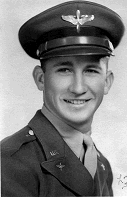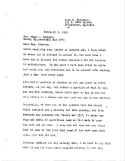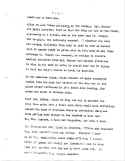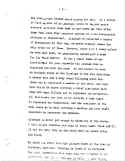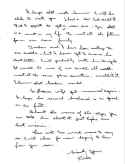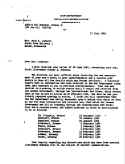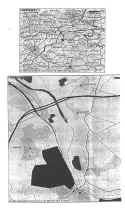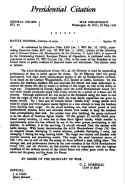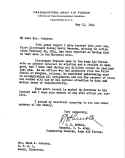|
He was a Minnesota boy. Sidney Swanson was born October 20, 1922 to Albin Swanson and Maud
(Fetter) Swanson at Maple Plain, Minnesota. He was the youngest of four boys; Wallace, Murray, and Edwin being his older brothers.
Early in Sidney’s life, he took on the nickname “Tino”. When Tino was about 8 years old, his parents
divorced. Maud later married Charles Johnson. Tino was all boy. He loved the outdoors, and animals.
Tino attended schools near where he lived. He attended Mound Consolidated High School. Always active in school affairs, he was president of the student council, secretary of his class, a member of the lettermen’s club and active in golf. He graduated in May 1940.
After graduation, he went to Wayzata where he was employed. Pearl Harbor prompted him to offer his services to his country and he reported to Ft. Snelling in the middle of December 1941 at the age of 19. On December 31, he was sent to Shephard Field, near Witchita Falls, Texas. It was there that he took his “boot training”. Later, he went to the Curtis Wright Tech School at Glendale, California for training as an aircraft mechanic. He completed training May 30, 1942.
Apparently, fixen
em’ wasn’t enough, he had to fly em’.
In September of 1942, Tino was found at the Lemoore Flying School in California as an air cadet. Here, he was assigned to 14 Squadron of Class 43-B. He completed his basic flight training on February 6, 1943 with the rating of pilot. On this day, he was awarded the commission of
2nd Lieutenant in the United States Army Air Corps.
Further training took place at the Army Advanced Flying School at Douglas, Arizona. He was assigned to Squadron VIII of class 43-B and completed training there in March 1943. He was able to take leave to see his family and friends in May. In June, he was at Gowen Field, Boise, Idaho. Records show that he took and passed Instrument Flying Tests at
AAB, Sioux City, Iowa on August 24, and at AAB, Scribner, Nebraska on October 7. It was probably here at Scribner that he formed the aircrew that was to go with him to Europe.
He was able to take leave and returned to Minnesota in September.
He passed another Instrument Flying Test at
AAB, Lincoln, Nebraska on November 10.
Tino wrote to his mother from Scribner, Nebraska on October
21, 1943. The letter from Tino included a photograph of the newly formed crew. The original photograph included the name, rank,
and duty of each crewman.
 |
Back row from left to right:
T/Sgt. J.A. Krauss, 1st Engineer & Top Gunner
2nd Lt. Ralph T. Clapps, Co-pilot
2nd Lt. Sidney D. Swanson, Pilot
2nd Lt. Al Raffy Jr., Bombardier
2nd Lt. Donald F. Zielinski, Navigator
Front row from left to right:
S/Sgt. Robert F. O’Gorman, Nose Turret Gunner
T/Sgt. Edwin H. Barker, Radio Operator
S/Sgt. Robert A. Graham, Asst. Engineer & Waist Gunner
S/Sgt. John D. Speakman, Tail Gunner
S/Sgt. Dudley W. Reaves, Belly Turret Gunner |
In the latter part of November 1943, the crew flew to Tibenham Air Base in England and arrived just before Christmas. They were part of the 701st Bomb Squadron, 445th Bomb Group, 2nd Air Division of the U.S. Army Air Corps.
The 445th Bomb Group was comprised of four squadrons. They were the 700th, 701st, 702nd, and 703rd Bomb Squadrons. There were more than 4,100 members of the 445th ; (notable among them was the movie actor, Jimmy
Stewart. Jimmy Stewart was the Squadron Commander, 703rd Bomb
Squadron, 445th Bomb Group.)
The first bombing mission undertaken by the 445th Bomb Group was on December 13, 1943. However, the first mission flown by Tino’s crew was on December 31. That mission, and the next six missions were bombing runs over French territory that were occupied by German forces.
Tino was promoted to 1st Lieutenant in January 1944.
Tino’s last letter to his mother was written on February 14, 1944.
“Dear Mom:
Got your very sweet letter today. So you’re gonna splurge a buck and take in a dinner for yourself, huh? Tell
Charlie the women wear shoes now, and the markets still smell about as bad. They had an air raid the last time I was there but it was on the outskirts so I only saw red flashes and heard the guns and bombs.
You can use some of my money if you
need it to continue your treatments Mom.
Not much to say ‘cept today is Valentines Day.
Will you be mine, huh? Love, “Tino”
The October 16, 1944 issue of Life Magazine contains an article by Charles
J.V. Murphy entitled The Unknown Battle. Several excerpts follow.
In five great sky battles, fought during the “Big Week” of last February, American bombers broke the back of German airpower and cleared Europe’s skies for
invasion. What Happened? The full story of the disappearance of the Luftwaffe will not become known until after the
war. But the fact of its disappearance as an effective air force is self-evident. Last February a great and decisive air battle was fought by the Anglo-American air forces. It lasted six days and was fought all over Western Europe, from the Zuider Zee to the Danube. That battle may go down in history as the airman’s
Cannae, a decisive battle in which one powerful air force, for the first time in history, annihilated another great air force.
Not even the airmen who fought this decisive battle have a name for it. Those whose bones ache with the memory of hard fighting remember it as the Big Week
…… the American air offensive in Europe, while meshed into the RAF offensive against the great German cities, was specifically directed against 177 industrial or military targets grouped in seven categories, the elimination of which would presumable deprive the Germans of the means to wage war. At the top of the target list were German aircraft plants. After the aircraft factories came 2) submarine yards, 3) transportation (locomotive shops, marshaling yards, waterways) 4) electric power, 5) oil, 6) aluminum, 7) rubber.
Big Week commenced on Sunday, February 20, 1944. Tino’s eighth mission, his first over Germany, was on Monday, February 21. His, was one of 924 heavy bombers that flew into the heart of Germany. Because clouds obscured their principal targets, the bombers turned their attention to secondary targets, or “targets of opportunity”. Tino dropped his bombs on an airfield at Achmer, Germany.
Of the original crew that left Scribner, Nebraska, there had been but two replacements. T/Sgt. Arthur J. Tinklepaugh replaced T/Sgt.
J.A. Krauss, Engineer and Top Gunner. Aside from it being winter, the bombers flew at very high
altitudes, which caused the temperature inside the airplanes to be below freezing. It was probably on the February 21st mission that 2nd Lt. Al Raffy’s hands were frostbitten. Lt. Raffy was replaced by Bombardier 2nd Lt. Bruce G.
Caturani..
Tino’s final mission was on Thursday, February 24, 1944.
The entire 2nd Air Division was composed of 13 Bomb Groups. The target this day was to be the Messerschmidt aircraft plant at
Gotha, Germany.
What follows is an account of unknown origin of what happened that day.
“ On 24 February the Second Bomb Division went to the ME110 assembly plant at
Gotha. A force of 235 Liberators crossed the Dutch coast. Flak was heavy over Lingen and the Liberators encountered persistent attacks by the
Luftwaffe. Even the arrival of three Thunderbolt Groups just after 12.00 hours was unable to prevent five Liberators from the 445th being shot down in the space of six minutes. Over 150 enemy fighters ferociously attacked the formation all the way to the target despite close attention from escorting fighters. The Division beat off incessant attacks as it the flew on over the Dummer Lake where it veered southeastwards to Osnabruck and the bombed-out airfields near Hanover. Three more 445th B-24s were shot down before the formation turned south near Gottingen at 12.53 hours. Nine minutes later a 445th B-24 belonging to the 703 squadron was shot down.
P-47 Thunderbolts had escorted the Liberators to the vicinity of Hanover and then the twin-boomed P-38 Lightnings and P-51 Mustangs orbited the formation as it proceeded to
Gotha. Undaunted, FW-190s, Me-110s, Me-210s, and JU-88s raked the
American formations with cannon and rocket-fire. Using the Liberators
thick vapor trails to excellent advantage, they often struck at any lagging bomber from below and behind. The Luftwaffe even attempted to disrupt the large and unwieldy combat
wings.
At 13.09 hours the Division changed course to the southeast with a feint towards
Meinegen. Some confusion arose at the IP when the navigator in the 389th lead ship suffered oxygen failure and veered off course. The bombardier slumped over his sight and accidentally tripped the bombs. Altogether twenty-five Liberators bombed the secondary target at Eisenach. Before the small 445th formation reached the target its tenth and eleventh victims fell to the German guns. By now the 445th consisted of only fourteen Liberators, three having aborted before entering Germany. Another 445th machine was shot down just after leaving
Eisenach.
The thirteen remaining 445th B-24s, realizing that they had veered off course, continued alone. They arrived over
the target at 13.25 hours and executed an eight-minute bomb run. Some 180 500-pounders dropped from 12,200 feet inflicted considerable damage on the Gotha plant. Other Second Bombardment Division Groups, totaling 171 Liberators dropped another 468 tons of assorted bombs from varying altitudes and directions.
The 445th’s thirteenth B-24 fell victim to the German defenses minutes after bombs away.
The plant’s destruction was well received by Eighth Bomber Command who estimated that six to seven week’s production would be lost.
The 445th alone lost 122 men on the bloody mission.
Tino’s mother was notified on March 16, that he was listed as missing in action. There were many letters from
friends and relatives encouraging her to not give up hope and that he may be a prisoner of war. However, on April 4, she received the dreaded telegram that read:
M 47 Govt WM Washington DC 12 54 PM
Mrs. Maude A Johnson, Rural Free Delivery One.
Mound, Minn.
Report received from the German Government through the International Red Cross states your son First Lieutenant Sidney D Swanson who was previously reported missing in action was killed in action twenty four February in the European area. The Secretary of War extends his deep sympathy .
Letter follows. 1.03 PM
Dunlop Acting the Adjutant General
The next day, April 5, Mrs. Johnson received a telegram from her son Wallace who was serving in the Army in
Europe. It read:
M Intl AMUBMI Apr. 5 1944
EFM Mrs. Maude Johnson, Rte 1, Bx 235
Mound, Minn.
You are more than ever in my thoughts at this time.
8 37 A-6 Wallace Swanson
In April , Mrs. Johnson received a letter from her son Edwin who was serving with the Marines in the Pacific. It read:
April 9, 1944
My Dear Mom.
Was so sorry to get the bad news this afternoon (Easter Sunday) of Tino, and I am waiting for a letter from you now hoping there has been a mistake. I got the news through the Red Cross, that he was killed in action, and am still hoping there has been a mistake made.
I know how you feel Mom, I wish in the worst way I could be home with you now as it must be pretty hard to take, especially the youngest brother. I only hope he didn’t die in vain, so that we, at least, won’t see any more wars. I know what I’ll tell them if there ever is another.
Well Mom, I guess there is little more that I can say. I hope that you don’t have to become a four star mother by
having to let Murray go too, for your sake at least one of us should be there. Don’t worry about me Mom. I’ll come home to you again. I am fine and making out well, so keep your chin up. G’bye now
Your loving son “Ed”
On February 24, the model B-24 H1 – CF Liberator piloted by Lt. Swanson was struck by German aircraft fire on its way to target at Gotha, Germany.
Five of the crewmen were able to parachute to safety, were immediately captured and imprisoned by the Germans. The other 5 crewmen were in the plane when it crashed. The Germans buried the dead in the Holtrup Community Cemetery just several hundred yards from the crash site. Later, the 5 deceased were re-interred at the American Military Cemetery,
Margraten, Holland.
In July 1945, Wallace was able to visit the cemetery and the grave of his brother. He made contact with a Dutch family that had made a special effort to care for Tino’s grave. The Stevens family had corresponded with Maud Johnson and she had been able to send them much needed parcels after the war.
It is at Margraten that the five rest with thousands of their American comrades.
The following is a letter that Wallace wrote his mother just after his visit to
Margraten.
July 28, 1945
Mummy Darling:
I have seen Tino’s grave. And now I will tell you what I did. First of all I was fortunate in being able to leave when I did. I talked to my Captain as soon as I received the information you sent me and he said as soon as there is a long trip back I will send you. It was only 2 days later that 5 men who are over 40 years old were to be sent home and they had to be transported to a place near Metz, France. I got the job of taking them. After dropping the men off, I traveled north through Luxembourg into Liege, Belgium, where I stayed for the night ( this was the 2nd night). The next
morning, I went to Holland. It was not difficult to find the cemetery or the grove. I got all the information that anyone could get. I learned at the office there that he had been moved from another cemetery in Germany to the present location. You
see Mum, in wartime, there is not sufficient time to transport them and have them all centrally located. So many are buried together with enemy dead. Tino’s grave is in Plot “L”, Row “6”, grave “144”. All graves are marked the same. Tino’s Dog tag is on his cross, which we can know for sure, is positive identification. The officer there told me there is positively no chance of a mixing when the “tags” are on the men. When the men have none, they usually have something on them to identify them, a paper, or laundry mark, as all of us usually have our serial number on all our clothing.
It was 11 A.M. July 26th. I had found him and was greatly relieved, but somewhat with a heavy heart. I wished
for my Mummy.
I knelt down and said a prayer for him. I also learned that an Army Chaplain is present there when they are
buried, so if they had no last rites before, they get them then. A Protestant Chaplain, and also a Catholic. At this time, I
took a few pictures. (I took more in the P.M. – will come to that later). The sun was not far enough west at that hour to take a picture of the side, which had his name on it, but I took a few. 6 I think. Then I went to look for the Stevens
residence. By some lucky fate there were four girls there that wanted a ride. I asked them if they knew the location of the town. (By the way you have it spelled wrong, That was the reason I could not find it on the map before). These girls straightened me out on that. It is
HEERLEN. They also knew where the town was. They also told me where the street was and they knew the people. They were not going that far, but with their help I was able to locate quickly and easily.
The girl Truus was not at home at that moment but came in about an hour. However, the rest of the family was aware of what it was all about. The whole family speaks English and Truus speaks very well. By the way, you were correct about the name. Truus is short for Gertrude. A very nice family indeed and from what I can see, of quite comfortable means. Mr. Stevens is an architect in a coalmine. Truus is studying medicine. All the rest of the kids are talented and very intelligent. Religion is prominent. Prayers before and after each meal. They promptly gave me some lunch, and then we started out to get some flowers for the grave. But I ran into some trouble as the M.P.s could not let me take hem in the truck. But that did not stop us! I sat in the truck while they got some flowers. I wanted to get a wreath, but orders could not be filled until 2 days. Roses were all that were available, so I took those and went alone to the cemetery and put them on Tino’s cross. At that time I took more pictures, I knelt down again and said the
Lord’s Prayer, said goodbye to him, saluted, and went on my way with the thought that all of us will feel better now that we know where he is. I would not be in favor of having him moved unless his buddies are.
Which brings me to the part of the letter which I want to say that I found them all but Bruce
Caturani; he is not buried there unless he is as an unknown. ( I would like to mention, before I forget that all markers have the tags on where possible and that on the tag is simply the name, first name, initial, and last name. And the beneficiary name is there too, as well as the soldier’s serial number.) The other men are all in the same row with
Tino.
Arthur Tinklepaugh is #126, serial # on dog tag 699558. I’m not sure if there is a 1 after the 8 or not. They way I scribbled it, I’m not certain. The other name on the tag is
R.T. Tinklepaugh, 414 Stanton St, W. Pittston, PA.
Dudley W. Reaves, #16169115, grave #127.
Next of kin: Donald D. Reaves, Rte #2, South Bend, Indiana
Donald Zielinski, #0-674714, same row, grave #145. No home address.
Ralph T. Clapps, #0-206965, same row, grave #146.
I happened to see the name of a Sgt. who is in Tino’s squadron. I am writing him to get the home address of the
2 men if possible.
I gave the Stevens family 1,000 Francs ( about $23.00 ) to get flowers for the grave. I told them it would be nice to think that when we were decorating graves at home, our Tino was not being forgotten. Mrs. Stevens said that our
boys had done so much for the Dutch people that this was the least they could do, to go and visit American graves. I was told I was always welcome there and if any of my family ever came to Europe to come there. I stayed over night at the Stevens home and left the next day.
The next 2 nights I spent in Liege, where I am now, at an Army Rest Center. It has been raining so I thought
I would wait until the weather cleared up. I plan on leaving early tomorrow for Czechoslovakia. The way I drive it was a little over 600 miles. I will see how far it is back as I will be going a shorter way. So I guess that about covers every thing. If you have any questions I will try to answer them as best I can,
so Bye Mum.
Bless you, and my love, x x x x x x.
Your little Boy Sgt. has grown up to be a man in the last few days. Wallace
I have 2 rolls of film, I don’t know if I should try to have them developed here and send them by letter, or send
the rolls. I am so afraid of them being lost. Or should I keep them until I get home and have them developed there. I will think it over a few days and come to some conclusion soon. I gave you the other names & addresses in case you want to write to them. I do not think I care to write them, so I will leave that to you.
Love again, Wally x x x
Mrs. Johnson was able to secure the names of the crewmembers and next of kin.
There was correspondence between these families for some years, especially at Christmas.
What follows are documents that are important to the story of these ten brave
men.
There are two letters from surviving crewmen that were written to Mrs. Johnson. These letters were probably the most difficult renderings ever for Jack Speakman and Robert
O’Gorman. Also a document listing the ten crewmen that were on the B-24 on February 24, 1944.
|

FOR A YOUNG AVIATOR.
O. Thou, who didst create this lad
And send him forth from Thee to roam
The spaces of the earth and sky,
Receive him now that he turns home.
He lived consorting with the stars,
And died the death which young gods die,
Who break their proud, resplendent wings
Combating evil in the sky.
Receive Thy son and give him place
Among the chosen ones whose wings
Protect Thy throne, that he may feel
Entrusted still with glorious things!
Adelaide Love

The Mother of My Son
By: Brooks Wilson
Missing in action over Germany – A tall and slender pilot, eyes as blue
As Carolina skies in spring, his hair
As golden as ripe wheat, fresh-washed in dew.
How can I bear this hurt, remembering
Last Easter, when his silver bars were new,
His youthful tenor soaring as he sang,
“Forgive them, for they know not what they do”?
Missing in action – my young son – yet I Must hold my tears. I dare not let them fall
Before his mother, sitting calm, strong-willed,
So lonely in our pew, no tears at all.

IN MEMORIUM 1945
In loving memory of Lt. Sidney D. Swanson who was killed
in action February 24th, 1944 over Germany:
Gone is the smiling face we loved so dear.
Silent is the voice we loved to hear,
You could not say goodbye to us.
You could not clasp our hand.
Rest for you dear Sidney, surcease from pain.
Our greatest loss, but heavens gain.
Sadly missed by mother, Mrs. Maud Johnson, and brothers, Wallace, Murray and Edwin Swanson.

IN MEMORIUM 1947
In loving memory of Lt. Sidney D. Swanson who was killed over Germany,
February 24th, 1944.
In “Margraten” Holland in a soldiers grave
Lies our dear Sidney among the brave;
He never shunned his Country’s call, but gladly gave his life, his all.
A faithful soldier’s noble end.
Always smiling, always content, loved and respected wherever he went.
Kind and unselfish, a son ever true, one in a million, dear “Sid”, that was you.

Home
Photo's
 Photos and Diary received in November 2011
Photos and Diary received in November 2011

from Brad Swanson, Sidney's nephew
Henk Dolman's adopter of Sidney's Grave

This site was created by dj1953
Last updated on
05/04/15
Send a comment or question to the
Web Master
All Rights reserved
2004-2011
|
|

